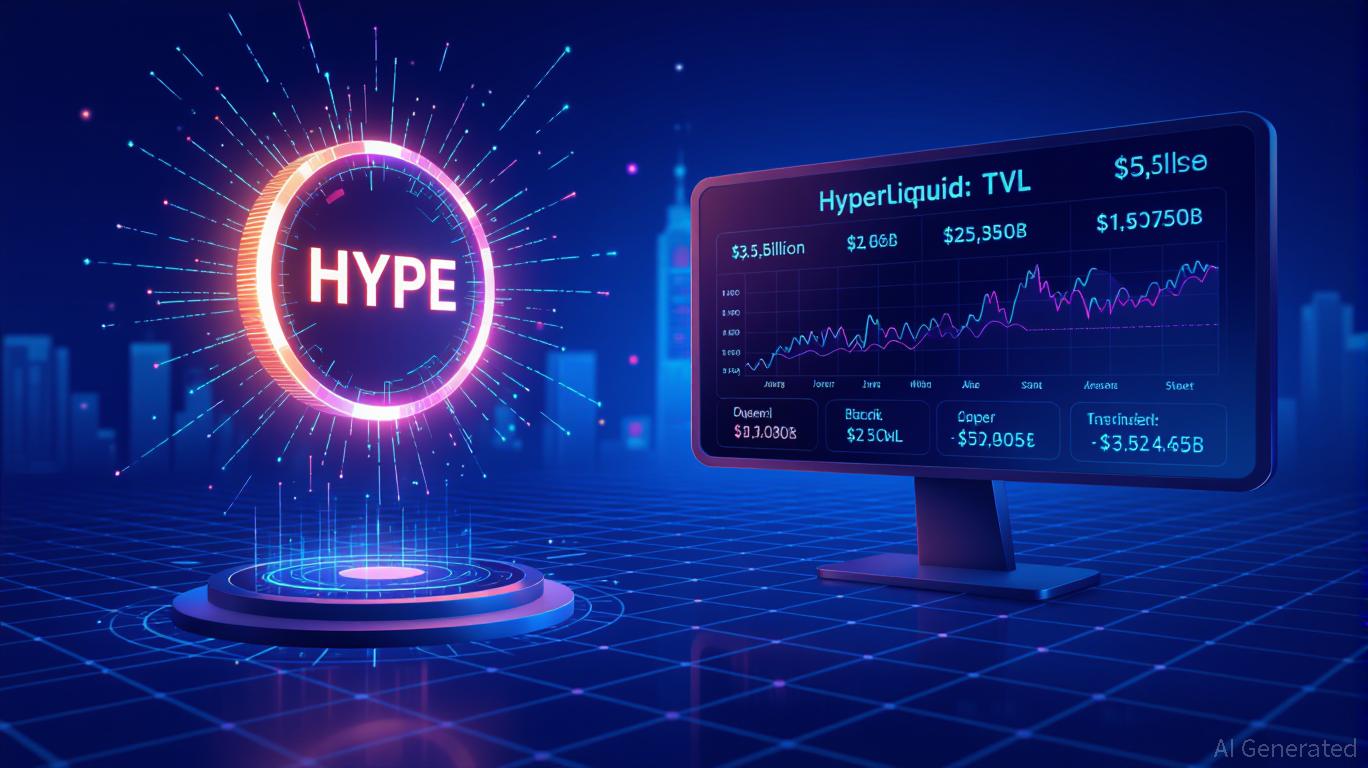Investing in the AI Race: Strategic Distribution for Countering Disinformation Technologies
- Generative AI has intensified the global disinformation crisis, with deepfakes accounting for 30% of viral misinformation in 2024. - The AI-driven disinformation mitigation market surged to $300M+ in 2025, driven by regulatory mandates and corporate reputation protection needs. - Key sectors include real-time fact-checking platforms (ActiveFence, Primer), AI literacy tools, and deepfake detection tech (Cognitive AI, Reality Defender). - Regulatory frameworks like the EU's DSA create $100M+ compliance mar

The worldwide challenge of disinformation has shifted from a mere social issue to a significant systemic threat, with generative AI fueling the rapid creation and distribution of fake content. By 2025, the market for AI-powered solutions to counter disinformation has attracted over $300 million in venture capital, propelled by regulatory requirements, businesses seeking to safeguard their reputations, and the existential danger posed by AI-generated deepfakes. For investors, this presents a rare chance to support companies developing scalable innovations in media literacy, fact-checking, and cybersecurity—fields that are set to transform digital trust in the age of artificial intelligence.
Generative AI: A Double-Edged Sword
The capacity of generative AI to produce convincing text, visuals, and audio on a massive scale has made it easier than ever for malicious actors to orchestrate complex disinformation efforts with little effort. According to a 2024 report by the European Digital Media Observatory (EDMO), political disinformation rose by 150% that year, with deepfakes making up 30% of the most widely shared falsehoods. At the same time, AI's tendency to "hallucinate"—creating content that sounds credible but is untrue—has undermined confidence in automated fact-checking systems. However, the very technology that spreads disinformation is now being harnessed to fight it.
Key Sectors for Targeted Investment
AI-Powered Fact-Checking Solutions
Companies such as ActiveFence and Primer are utilizing advanced natural language processing (NLP) to monitor shifting narratives and identify harmful content in real time. The $100 million investment in ActiveFence reflects strong investor belief in its ability to uncover coordinated disinformation, as seen in its response to the January 2025 incident in Brazil's capital. Primer's $168 million funding round highlights the growing need for tools that help businesses address misinformation—such as a fast-food company's packaging scare—before it damages their reputation.Media Literacy and Educational Platforms
The adoption of AI in educational settings is accelerating, with projects like those at the Gunnison Watershed School District in Colorado and Queen Mary University of London incorporating AI literacy into news and academic processes. These initiatives focus on critical thinking, ethical AI practices, and practical uses like grammar correction and data analysis. The global demand for AI literacy tools is expected to grow by 40% annually, spurred by regulations such as the EU's Digital Services Act (DSA), which requires platforms to take responsibility for harmful content.Cybersecurity and Deepfake Identification
The proliferation of synthetic media has increased the need for specialized detection tools. Cognitive AI's Pixels platform, which uses deep learning to spot image alterations, and Reality Defender's deepfake detection technology—backed by $15 million in funding—demonstrate the sector's promise. These solutions are vital for industries like law, public safety, and journalism, where verifying authenticity is essential.
Regulatory Forces and Market Shifts
The DSA's penalty of 6% of global revenue for non-compliance has created a market worth over $100 million for compliance solutions, with startups like ActiveFence and VineSight (which secured $4 million for its source-tracing technology) emerging as key partners for major platforms such as Meta and Google. At the same time, companies are increasingly seeking real-time monitoring: In 2024, engineering firm Arup suffered a $25 million loss due to a deepfake scam, highlighting the financial risks at stake.
Risks and Ethical Dilemmas for Investors
Despite the sector's rapid expansion, several obstacles remain. Fragmented regulations—like the use of mitigation tools for censorship by authoritarian governments—introduce geopolitical uncertainties. The fast-paced development of AI-generated disinformation has also sparked a technological arms race, demanding constant innovation. Investors must also consider ethical issues, including privacy concerns related to surveillance technologies and the risk that dominant AI analytics firms could suppress competition.
Why Early Investment Matters
The market for combating disinformation is still in its formative stages. Startups with robust AI technology, clear strategies for regulatory compliance, and a dedication to protecting civil liberties are best positioned for growth. For instance, Clarity (which received seed funding in 2025) and Reken (founded by a former Google executive) are building tools to detect synthetic media and monitor harmful content. Meanwhile, Rative and Tidyrise are focusing on managing social media threats using AI-powered analytics and automated interventions.
Conclusion: A Strong Long-Term Investment
Investors aiming to benefit from the surge in AI-based disinformation defense should focus on companies that offer:
- Scalable, evidence-based solutions (such as VineSight's source-tracing technology).
- Compliance with regulations (like tools that meet DSA standards).
- Versatility across industries (for example, Cognitive AI's offerings for legal and media sectors).
With the Global Risks Report 2025 identifying disinformation as the leading long-term threat, the need for these technologies will only grow. By investing in innovators in this space, investors can protect themselves from systemic risks and secure a leading position in a market that is redefining the future of digital trust.
Disclaimer: The content of this article solely reflects the author's opinion and does not represent the platform in any capacity. This article is not intended to serve as a reference for making investment decisions.
You may also like
Central Bank Issues Historic Penalty: Adhering to Crypto Regulations Is Now Essential
- Ireland's Central Bank fined Coinbase Europe €21.5M for AML/CFT failures, marking its first crypto enforcement action. - Systemic flaws allowed 30M unmonitored transactions (€176B) due to software errors and governance gaps. - Regulators emphasized crypto compliance urgency, citing MiCA regulations and law enforcement collaboration risks. - Coinbase acknowledged technical errors but faced reduced penalties via early settlement under regulatory programs. - Case highlights EU's intensified crypto oversight
Fed's Balancing Act: Navigating Inflation and Employment in the 2025 Interest Rate Challenge
- The Fed debates 2025 rate cuts to balance 3% inflation control with a cooling labor market, as policymakers like Jefferson advocate a slow easing approach. - Mixed signals persist: U.S.-China trade deal eased volatility but left businesses cautious, while Matson's 12.8% China service decline highlights lingering tensions. - Market expects 25-basis-point December cut, but Powell warns uncertainty remains, compounded by government shutdown limiting key data access. - Rate-cut expectations boosted municipal

Bitcoin News Update: Institutions Pour In Funds Despite Bitcoin Downturn: ETFs Draw $240M During Market Turbulence
- Bitcoin ETFs saw $240M net inflows on Nov 6, ending a six-day outflow streak led by BlackRock's IBIT and Fidelity's FBTC. - Despite Bitcoin's 9% weekly price drop to $100,768, institutional confidence grew in regulated, low-fee ETF products amid market volatility. - Altcoin ETFs gained traction while total crypto ETPs faced $246.6M outflows, highlighting diverging investor priorities. - Analysts attribute Bitcoin's decline to internal dynamics, not ETFs, as on-chain data shows easing sell-pressure and st

Hyperliquid's 2025 Boom: Blockchain-Based Liquidity and Shifting Retail Trading Trends
- Hyperliquid's TVL surged to $5B in Q3 2025, capturing 73% of decentralized perpetual trading volume via on-chain liquidity and retail demand. - Technological innovations like HyperEVM and strategic partnerships drove $15B open interest, outpacing centralized rivals' combined liquidity. - Retail traders executed extreme leverage (20x BTC/XRP shorts) and $47B weekly volumes, highlighting both platform appeal and liquidation risks. - Institutional interest (21Shares ETF application) and deflationary tokenom
